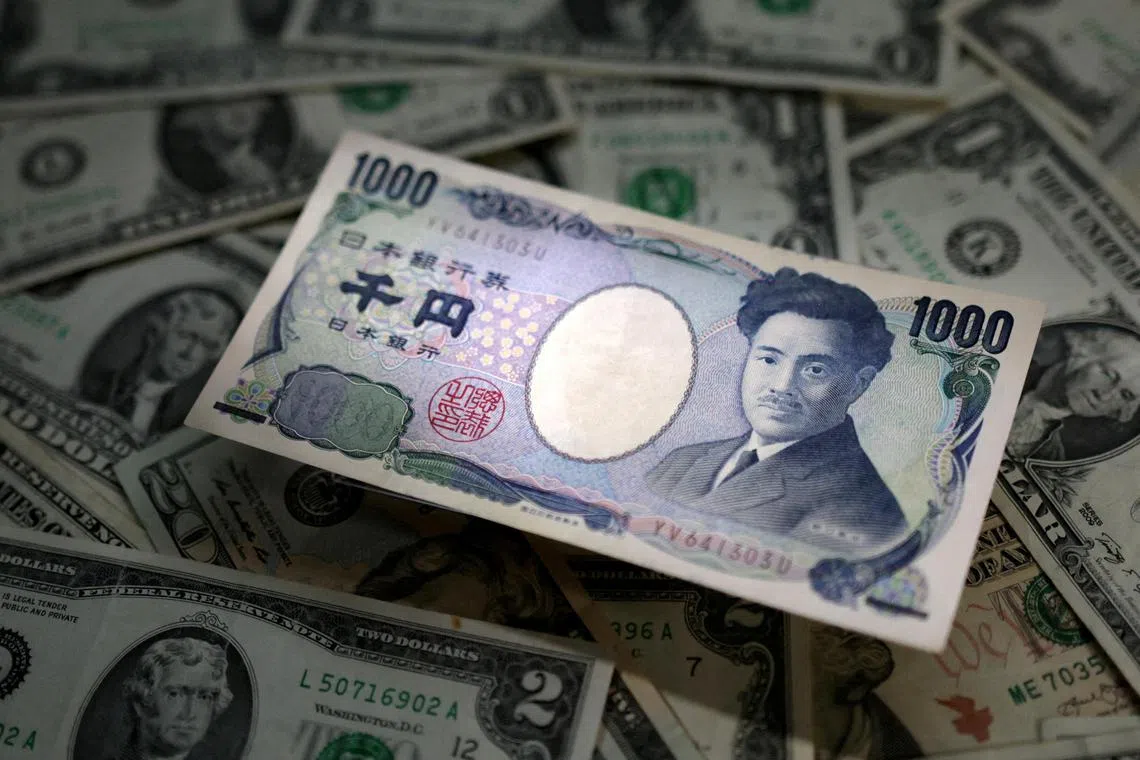Yen surges against USD, Singdollar as traders bet on early BOJ rate hike
Sign up now: Get ST's newsletters delivered to your inbox

The yen is still down almost 10 per cent against the Singapore dollar in 2023.
PHOTO: REUTERS
Follow topic:
TOKYO – The rally in the yen spilt over into its second day as traders wagered that the Bank of Japan (BOJ) will scrap the world’s last negative interest rate regime much sooner than previously thought.
The currency advanced as much as 1.1 per cent against the United States dollar on Dec 8, after briefly jumping almost 4 per cent in New York overnight.
The yen strengthened to 107.91 against the Singdollar as at 7pm on Dec 8 in Singapore, levels last seen in September.
The Singapore dollar had been strengthening against the yen since the start of 2023, surpassing 112 to reach its strongest level on record versus the Japanese currency in November.
The yen’s rally may have been amplified by speculators closing bearish wagers on the currency, after leveraged funds boosted these to the highest level in more than a year in late November.
There were also suggestions that a lack of liquidity and algorithmic trading exacerbated the spike.
“Yen-short positions may have been liquidated considerably,” said Daiwa Securities senior currency strategist Yukio Ishizuki, who added that stop-loss trades were also likely triggered.
“Soft US jobs data later today may spur more dollar selling, with 141 for the yen in sight again.”
The yen traded at 144.43 to the US dollar as at 7pm in Singapore, as traders also began looking ahead to the US non-farm payrolls report. That may provide more evidence of a cooling labour market heading into next week’s Federal Reserve policy meeting.
Comments from BOJ governor Kazuo Ueda earlier on Dec 7, along with remarks from one of his deputies on Dec 6, jolted financial markets in Tokyo and globally. The sharp push for the yen saw it appreciate against all of its peers in the Group of 10 (G-10) on Dec 7.
Economists increasingly expect the central bank to achieve its inflation target, while remaining less aggressive than traders in expectations for how soon the BOJ will move. A growing majority of economists forecast that the negative rate regime will end by April, according to a Bloomberg survey.
They are focused on whether Mr Ueda gives any indication of changes to come in a policy statement or at his press conference following the next decision on Dec 19, rather than any outright change in settings that soon.
“The odds of tightening administered rates on Dec 19 are still a bit of a long shot,” said Mr Bipan Rai, global head of foreign exchange strategy at Canadian Imperial Bank of Commerce in Toronto. “In conjunction with greater certainty that the Federal Reserve is done with rate hikes, the risk-reward of (US dollar/Japanese yen) longs has shifted materially.”
The yen’s rally on Dec 7 was the biggest since the BOJ blindsided investors in December 2022, after then governor Haruhiko Kuroda doubled the cap on 10-year yields, sparking bets on policy normalisation.
Mr Ueda, who took the helm in April, has maintained a cautious approach and gradually widened the yield curve control in 2023. He kept ultra-loose monetary policies in place at a time when other major central banks were increasing interest rates to contain global price growth.
BOJ officials have said the bank is not confident enough yet about attaining the price goal of stable inflation at 2 per cent accompanied by wage growth.
The yen is still down about 9 per cent against the US dollar in 2023 – and almost 10 per cent against the Singdollar – the second-worst performance among G-10 peers. BLOOMBERG

